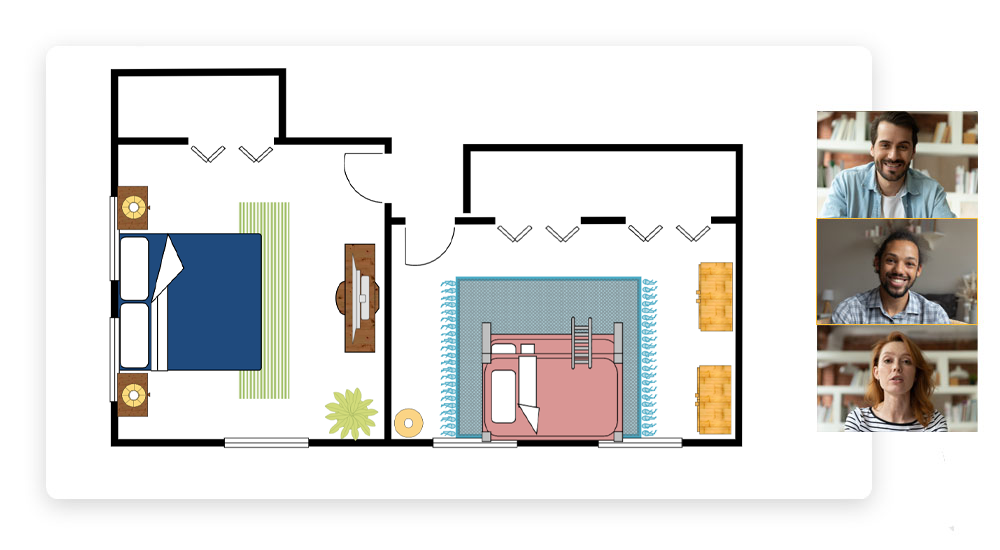Unleash Your Inner Developer With Room Designer Insights
Discovering the intricate globe of interior decoration can be a rewarding journey, loaded with limitless possibilities to change living rooms into individualized refuges. Room Developer Insights supply a comprehensive guide to understanding the nuances of shade psychology, furnishings positioning, lights techniques, and the art of blending textures and patterns. By delving right into these understandings, people can open the potential to create rooms that not just reflect their unique design yet additionally stimulate a feeling of consistency and comfort. Let's dive into the realm of indoor layout and reveal the tricks that can unleash your inner developer.
Comprehending Color Psychology
Analyzing the influence of color on human feelings and behavior is important in indoor layout. Shades have the power to evoke specific sensations and set the tone for a space, making it important for designers to understand color psychology. Cozy shades like red, orange, and yellow can produce a relaxing and inviting ambience, ideal for social spaces like living kitchen areas or areas. On the various other hand, cool shades like blue, eco-friendly, and purple can advertise leisure and serenity, making them perfect for rooms or home workplaces.
It is important to think about private and cultural differences when selecting colors for a space, as particular shades may have various significances or associations across numerous teams. By meticulously choosing and integrating colors based on their psychological effects, interior designers can develop unified and impactful spaces that cater to the emotions and behaviors of the inhabitants.
Furniture Placement Tips
When setting up furniture in an area, calculated placement can dramatically affect the functionality and looks of the space. One key tip is to think about the room's prime focus, such as a fireplace, large home window, or home entertainment facility, and orient the furnishings around it. This creates a feeling of balance and draws focus to the room's standout feature.

An additional essential factor to consider is the range and proportion of the furnishings. Ensure that the dimension of the furnishings matches the size of the space. Avoid overcrowding by leaving adequate space in between pieces for a comfy and visually pleasing design.
Lights Techniques for Ambiance
Efficient illumination strategies play an essential role in setting the atmosphere and state of mind of a space, improving its overall ambience and functionality. Ambient lighting provides total lighting, commonly via ceiling-mounted fixtures or wall sconces, creating a comfortable level of illumination in the space.
Along with the kinds of illumination, the color temperature of light bulbs likewise affects the setting. Warmer Click Here tones (around 2700-3000 Kelvin) develop a comfortable and welcoming ambience, suitable for living bedrooms and areas, while cooler tones (around 3500-4100 Kelvin) are a lot more invigorating and ideal for task-oriented locations like kitchens or home workplaces. By why not find out more tactically integrating various lights types and readjusting shade temperatures, you can change a room right into a flexible and welcoming space.
Combining Patterns and Structures
To boost the aesthetic appeal and depth of a space, skillfully integrating a mix of patterns and structures can bring a dynamic and engaging facet to the room. Mixing structures, such as smooth velour with harsh woven products, adds tactile rate of interest and can make a room really feel a lot more welcoming.
:strip_icc()/KrywickiInteriorDesign_092419_04-49c162c8b3ff4d028d938f720f2b79d1.jpg)
Remember to layer patterns and structures attentively throughout the area, including them in products like rugs, toss cushions, drapes, and upholstery. This approach enables an aesthetically revitalizing setting that reflects your one-of-a-kind design sensibilities.
Customizing Your Space
Incorporating individual touches right into your living area can transform it into a reflection of your special character and style preferences. Personalizing your space involves infusing components that reverberate with you on a deeper degree.
Another means to customize your room is by incorporating shades that stimulate specific feelings or memories. Whether you choose soothing blues, energizing yellows, or innovative neutrals, choosing tones that resonate with you can create a more welcoming atmosphere. Furthermore, integrating personalized decor such as personalized picture frameworks, monogrammed throw cushions, or hand-made crafts can even more improve the individuality of your area.
In addition, don't undervalue the power of integrating components that reflect your pastimes, interests, or social background. Whether it's a shelf loaded with your favored reads, a gallery wall surface look at here showcasing your photography skills, or fabrics that celebrate your heritage, these individual touches can really make your room feel like home.
Conclusion
Integrating color psychology, strategic furniture placement, efficient lighting methods, and the art of blending structures and patterns can transform any space right into a unified and visually enticing area. Personalizing the design additionally boosts the general visual, creating an area that shows private design and personality. By applying these insights, interior layout skills can be elevated, leading to a practical and aesthetically pleasing living environment.
Cozy shades like red, orange, and yellow can develop a comfortable and welcoming ambience, excellent for social spaces like living spaces or kitchens.When organizing furniture in a room, strategic placement can dramatically affect the capability and looks of the room. By strategically incorporating different lights types and adjusting color temperatures, you can change a room right into a versatile and welcoming area.
Furthermore, take into consideration the design of the room-- for a more traditional room, choose for classic patterns like stripes or damask, while a modern-day area might profit from abstract or geometric layouts. - Furniture Stores Near Me
Incorporating shade psychology, calculated furniture placement, efficient lighting strategies, and the art of mixing textures and patterns can change any space into a aesthetically attractive and harmonious space.